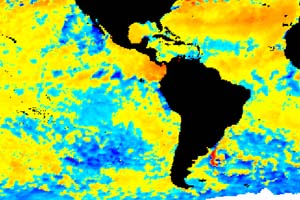| NOAA Magazine || NOAA Home Page || Previous Story |
LA NIÑA PLAYS POSSUM
 July
11, 2003 � What looked like the development of La Niña has stalled,
at least for now, say scientists at the NOAA
Climate Prediction Center in their latest El Niño/Southern
Oscillation (ENSO)
Diagnostic Discussion. While earlier this Spring cooler-than-average
surface and subsurface water temperatures developed in the central and
eastern equatorial Pacific, present subsurface conditions are now near
normal and negative sea-surface temperature departures from normal in
the eastern equatorial Pacific have weakened by up to two degrees Fahrenheit.
(Click NOAA satellite image for larger view of latest sea surface
temperatures in the equatorial Pacific taken July 8, 2003. Cooler sea
surface temperatures are represented in blue off the coast of South
America. Please credit “NOAA.”)
July
11, 2003 � What looked like the development of La Niña has stalled,
at least for now, say scientists at the NOAA
Climate Prediction Center in their latest El Niño/Southern
Oscillation (ENSO)
Diagnostic Discussion. While earlier this Spring cooler-than-average
surface and subsurface water temperatures developed in the central and
eastern equatorial Pacific, present subsurface conditions are now near
normal and negative sea-surface temperature departures from normal in
the eastern equatorial Pacific have weakened by up to two degrees Fahrenheit.
(Click NOAA satellite image for larger view of latest sea surface
temperatures in the equatorial Pacific taken July 8, 2003. Cooler sea
surface temperatures are represented in blue off the coast of South
America. Please credit “NOAA.”)
“This reversal in the temperature trend is related to a weakening of the equatorial easterly winds that occurred in late May and early June,” says Vernon Kousky, ENSO specialist at NOAA. “The latest statistical and coupled computer model forecasts indicate considerable uncertainty for the next several months. However, the majority of the forecasts indicate near-normal conditions in the tropical Pacific during the last half of 2003.”
In the absence of El Niño and La Niña there will be a higher degree of uncertainty in what we can expect in regards to temperature and precipitation patterns over the United States during the next several months and into the fall.
The ENSO Diagnostic Discussion is published monthly by the NOAA Climate Prediction Center and is a consolidated effort of NOAA and its funded institutions. The NOAA Climate Prediction Center predicts and monitors El Niño/La Niña and also produces the nation’s official long-range outlooks and medium-range weather forecasts.
NOAA is dedicated to enhancing economic security and national safety through the prediction and research of weather and climate-related events and providing environmental stewardship of the nation�s coastal and marine resources. NOAA is part of the U.S. Department of Commerce.
Relevant Web Sites
NOAA
El Ni�o/Southern Oscillation (ENSO) Discussion
NOAA Climate Prediction Center
Media
Contact:
Carmeyia
Gillis, NOAA Climate Prediction
Center, (301) 763-8000 ext. 7163